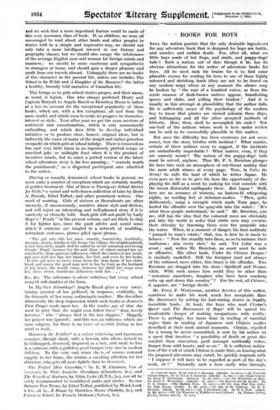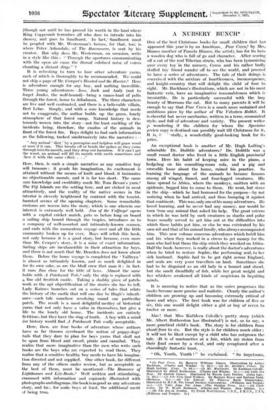BOOKS BOYS
STILL the notion persists that the only desirable ingredients for any adventure book that is designed for boys are battle, and murder, and sudden death. For, after all, what are little boys made of but frogs, and snails, and puppy-dogs' tails ?. Such a notion, out of date -though it be, has its obVions attractions for the writer of adventure books for boys. All he need rack his brains for . is to find some plausible excuse for sending his hero to one of those highly coloured sand shrieking lands (they are not to _be. found on any modern -map) where at any moment the silence may be broken by " the roar of a hundred voices, as from the scrub swarms of dark-brown natives appear, brandishing spears and clubs, and yelling their loudest." And it is usually in this attempt at plausibility that the author fails. He is sufficiently aware of the psychology of the modern boy to know that pirates are viewed askance these days, and kidnapping and all the other accepted methods of hitherto. How, then, shall he accomplish his ends ? Not one-half of the authors whose work is here under review can be said to be successfully plausible in this matter. .
But once the difficulty has been overcome (or not over- come), how the story bristles with incident I What matter, certain of these authors seem to suggest, if the incidents are undoubtedly improbable ? What matter, even, if they are scarcely moral ? The notion of the puppy-dogs' tails must be served, anyhow. Thus Mr. F. S. Brereton plunges his hero into such an atmosphere of cut-throat mutiny that the mere adult winces at every page. True, in Colin the ScoUt,1 he calls the land Of which he Writes Japan. He even goes so far as to give his hero the opportunity of dis- playing his skill as a scout by making his visit coincide with the recent distressful earthquake there. But Japan ? Well, here are no avenues of wisteria, no lantern-lit whispering nights, no rustling feet of rickshaw-coolieS. " Then, quite deliberately, using a strength which made Tony gape, he hurled the offender over the quayside into the water : It's what these people understand,' he said." Mr. Brereton, you see, still has the idea that the coloured races are obviously put into the world in order that- white men may exercise their chivalry by throwing them over the quayside into the water. When, in a moment of 'danger, his hero Suddenly " jumped to man's estate," that, too, is how he is made to behave : " Now fire steadily into them, so as to, increase their confusion ; aim every shot," he said. Yet Colin was a scout ; and, writes Mr. Brereton, no scout must be rude or offensive. His other book, Under the Chinese Dragon,2 is similarly modelled. Still the foreigner (and not always of the coloured races either, this time) is the Offender. Two Russians are dragged into the story—Spolikoff and Ovarto- vitch. With such names how could they be other than " notorious anarchists, burglars who have been cracking cribs up and down this country" ? For the rest, all Chinese, it appears; are " foreign devils."
Mr. Percy F. Westerman, another devotee of this notion, contrives to make his work much less acceptable than Mr. Brereton's by setting his hair-raising stories in. frankly incredible lands. At least, the boys who read Clinton's Quest' and The Buccaneers of Boya4 will be spared the incalculable danger of making comparisons with reality. There is, perhaps, less harm dOne in reading of cannibal orgies thari in reading of Japanese and Chinese coolies described at their most animal. Moments. Clinton, expelled for a. wrong he never committed; is sent by his author on a quest that involves " a possibility of death or great dis- comfort from starvation, peril amongst unfrfetrdly tribes, danger-from wild beasts, and soon." It is sufficient indica- tion ofthe stuff of which ''clintenis.inetcle that on hearing what the proposed adventure may entail, be quickly responds with " I suppose it will have to be regarded as part of .the day's work, sir ?," Naturally such- a hero easily wins through,
•
(1) Cohn the Scout. By Lt: Col. F. S. Brereton. (Mackie. 5s. net) (2) Under the Chinese Dragon, By Lt.-Col. S. thereton. (Mackie..3s. -644-0) Ciintos•solest. By Percy F. Westerman. (Pearson. 3s. 6d. net.),(4) The Buccaneers of Boma. By Percy F. Westerman. (Mackie. 6s. Buried and the Bunter. By E. E. Cowper. • (The iSieldon Press. 22. "net.)-(6I The Ship .That Was Eaten. By Tom Bevan. (Castle. 3s. 6(1. net , (7) Jim of the Valfreya. By B., L. Bearden. (Black. 2s. 6d. liet.)-.--(8) A Patchwork %ak. By W. F. Peck. thikk. Zs. M. Ihe-Eonseace Tighthoiace Wur-Lifeks.rts. By Thomas Corbin, (Seeley, Service and Co. es. net.) (though not until he has proved his worth in the land where King Coppernob- terrorizes all who dare to intrude into his shores), and goes to Sandhurst. In -faet,'--Sandhurst must be peopled with- Mr. Westerman's heroes,- for that, too; is where Peter- Arkendak;,of The Buccaneers, is sent by his creator. But .why does,. Mr., Westerman, on occasion,. write in a style like this : " Through the apertures communicating with the open air came the dismal subdued noise of voices chanting a distant. dirge" ?
It is refreshing to turn to four other adventure yarns, each of which is thoroughly to be recommended. We could not skip a page of Mr: Cowper's Hunted and the Hunter.5 Here is adventure enough for any, boy, and nothing incredible. Three young adventurers—Jess, Jack and Andy (not to forget Junko, the wolf-hound)---bring a canoe-load of pelts through the forest, home to Athabasca. The three characters are live and well contrasted, and there is a believable villain, Bert Lelac. Simply, and with a sure knowledge that needs not to exaggerate, the author builds up the green, lonely atmosphere of that forest camp. Natural history is dex- terously woven into the story—not the least exciting of the incidents being, therefore, the exodus of the animals in front of the forest fire. Boys delight to find such information as the following; tucked unobtrusively into the narrative " Any animal idiot,' by a porcupine and helpless will gnaw wood at once if it can. This breaks off or bends the spikes as they come through into the mouth, and they drop out harmless. If it can't get the wood, an animal will fill its mouth with earth sometimes and thew it with the same riTect. . . ."
Here, then, is such a -simple narrative as any sensitive boy will treasure : it goads his imagination, its excitement is
attained without the means of knife and blood, it insinuates no objectionable morals, and it is far too short. The same sure knowledge and credibility mark Mr. Tom Bevan's yarn.., The Fiji Islands are the setting here, and are etched in most attractively, and the reality of the native scenes in the interior is cleverly heightened by contrast with the tourist- haunted scenes of the opening chapters. Some remarkable customs are woven into the story, which is one -wherein our
interest is extremely well held. Jim of the Valfreya7 .apens with a capital cricket match, puts us before long on board a sailing ship bound through the tropics, introduces us to a company of well-assorted and intimately-known seamen,
and ends with the momentous voyage over and all the little
community broken up for. ever. Boys will relish this book,
not only because it -is .a good itory, but because, even more than Mr. Cowper's story,. it is a. mine of exact information. Sailing ships are inexhaustible in their attraction for boYs, and there is not much that Mr. Dearden does not know about them. Before the home voyage is completed the Valfreya ' is almost as intimately known, and as much delighted in for its own sake, as are the bluff crew that man it ; in fact,
it runs Jim close for the title of hero. Almost the same holds with A Patchwork Tale,e only the ship is replaced with a fine old Scottish castle. Taking a shabby piece of patch-
work as the apt objectification of the stories she has to tell, Lady Kaimes launches out on a series of tales that relate the history of. the castle that will one day be Hugh's inherit- ance—each talc somehow revolving round one particular
patch. The result is a most delightful medley of -historical yarns that not only have a value -in themselves, but give a life to the lonely old house. The incidents are entirely fictitious, but they have the ring of truth. A boy with a mind., l'or history would find .4 Patchwork Tale really acceptable.
Here, then, are lour- books of adventure whose authors
have so far thrown overboard the notion of ptippy-dOgs'. tails that they dare to plan for boys yarns that shall not be spun from blood and sword, pirate and cannibal. They realize that more iniaginative than the men who write such books are the boys who arc expected to read them. They realize that a sensitive healthy boy needs to have his imagina- tion directed and not supplied. One other book, far different from any of the others, under review, but as acceptable as the best of them, must be mentioned—The Romance of Lighthouses and Life-Boats.° Well written and stimulating, crammed with information and copiously illustrated with photographs and diagrams, the book is as good as any adventure story, and- has, for-sorrie -boys at least, the additional' merit of being true.



































































 Previous page
Previous page